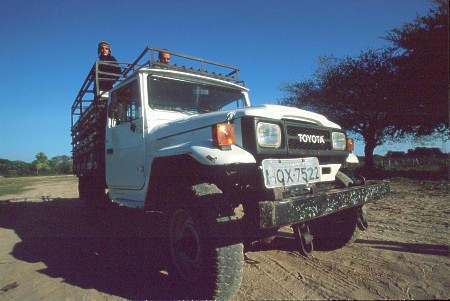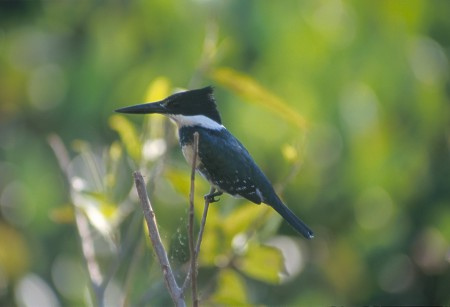Pantanal Culture: Food
The following recipes are typical of the region. You can try these for yourself - although some of the ingredients may be hard to find unless you're living in Brazil. You can make substitutions for local ingredients … although we're not really sure what fish can be substituted for piranha.
Caldo de piranha
Spicy Piranha Soup. Piranha is a small bony fish. It doesn't have much meat, meaning that its not a fish you can fillet or pan fry (although we have experimented with it thinly sliced and made into sashimi). The secret for cooking piranha is that you need a lot of them, freshly caught. But this isn't a problem in the Pantanal.
Ingredients:
Ingredient Quantity Piranha (yellow piranha are best) 4 fish Tomatoes with seeds removed 4 Onions (chopped) 3 medium Mixture of chopped spring onions, coriander and parsley 2 cups Ground Annatto spice (Colorau or Urucum in Portuguese) 2 Tsp (optional) Chili pepper (dedo de moça) 3 Oil, Salt and pepper vary to taste
Preparation:
Some variations of this recipe also add garlic and vegetables into the broth, so be prepared to experiment to get the flavors you like:
- Clean the piranha. Put them into a pot (ideally a pressure cooker), cover them with water, then boil for about 10 minutes.
- Leave to cool a little, then pour the piranha mixture into a blender. Blend for 2-4 minutes. This creates a piranha stock, which should be passed through a sieve to remove the bones.
- In a large pot, lightly fry the onions with 1-2 tsp oil. Then add the tomatoes, salt and pepper.
- After a couple of minutes, add in the piranha stock, along with the annatto, the mix of spring onions, coriander, and parsley, and the chilis.
- Bring the mixture to boil - then leave to simmer for about 25 mins.
Sopa Paraguaia
Paraguayan Soup. Despite the name, this is actually a type of savory cake or cornbread (see Sopa Paraguaia wikipedia article). This is often served to accompany barbecued meat.
Ingredients:
Ingredient Quantity Butter or oil 8 Tsp Onions 2 medium Cottage cheese 1 cup (250g) Grated mozzarella cheese 1 cup Polenta or cornmeal 1 1/2 cups Corn kernels 1 can (400g) Creamed corn 1 can (400g) Salt 1 tsp Milk 1/2 cup Eggs 6
Preparation:
This is one variation of many different Sopa Paraguaia recipes. Most Brazilian versions (as per the video below) omit the cottage cheese and canned corn. Some add 1-2 tsp of baking power to give a lighter consistency. Everything is combined into a batter, then poured into a baking pan, and baked in the oven.
- Heat half the butter in a frying pan and cook the onions over moderate heat until tender but not brown. Set aside.
- Beat the eggs together for two minutes.
- Pour the remaining melted batter, onions, and cornmeal in with the eggs. Mix thoroughly.
- Add the corn kernels, creamed corn, salt, and milk into this egg mix, and continue mixing thoroughly.
- Finally add the Cottage cheese and Mozzarella cheese, mix until thoroughly combined.
- Pour the batter into a greased and floured baking pan 25 cm x 30 cm (10 inch by 13 inch) and bake in a preheated oven at 200°C (400F) oven for 30 to 40 minutes, or until a toothpick inserted in the center comes out clean.
Picanha
Brazilian BBQ Beef: This is one of Brazil's most savored dishes. The cut of meat used is Top Sirloin or Rump Cap. This meat cut is protected by a thick layer of fat - which is left intact to infuse the meat with more flavour as gets barbecued. The meat is rolled in or sprinkled with rock salt about 10 minutes prior to cooking so that this saltiness is also infused during the barbecue process.
Arroz Boiadeiro
Pantaneiro Cowboy Rice. This is typically served to the cowboys working on cattle ranches in and around the Pantanal. It's simple to cook over camp fires, and the ingredients are readily transportable.
Ingredients:
Ingredient Quantity Uncooked Rice 1 1/2 cups Beef (traditional recipe uses dry carne de sol, but regular beef is okay) 300g Salt (not needed if using dried beef, which is already salted) 2 tsp Pepperoni or sausage 100g Bacon 200g Onion (sliced) 1 large Minced garlic 2 tsp Red capsicum (sliced). Use chili instead for more bite 1 Black Pepper 1 tsp Chopped Parsley 2 tsp Green plantain banana (sliced then fried) 1
Preparation:
This recipe has many variations (see the linked video below for another).
- Cook the beef. Once cooked shred it, or cut into small cubes.
- Add the bacon and sausage with the meat and continue frying. Then mix in the onion, garlic and capsicum/chili, and fry for a few more minutes.
- Add the uncooked rice and salt (if needed). Fry this together with the meat so that the uncooked rice is coated.
- Finally pour in enough the boiling water to cover the entire mixture (about two cups). Mix, and leave to cook.
- Once ready place the rice into a bowl, mixed with the fried plantain banana cut into chunks.
External Recipe Links
Other typical Brazilian foods that you'll find in the Pantanal are:
Feijoada.
This a traditional black bean stew, served with pork, sausage, and sometimes with beef. It originated in Bahia but is now found throughout Brazil. It's typically served with rice and farofa.
Coxinhas de Galinha
This is a traditional chicken savoury, often served in street stalls, bus stations and airports. It consists of a chicken savoury filling that's been wrapped in a doughy mix of flour and mashed potato, covered in bread crumbs, and then deep fried.
Moqueca de Pintado
Pintado is one several large catfish species living in the Pantanal region. The name Pintado (meaning "painted") derives from the catfish's spotted appearance. There's also another very similar catfish called Cachara, which has stripes rather than spots.
There are many different recipes - including deep frying. However, this recipe is a variation of a favourite African-inspired Moqueca dish from Bahia. Dendê red palm oil originated from Africa, where it's used in a lot of traditional cuisine. This was brought to Brazil during the slavery period.
Ingredients:
Ingredient Quantity Pintado steaks or fillet 1 kg Tomatoes 1 kg Onion 2 medium Capsicum (try to mix red and yellow) 2 Coconut Cream 500 ml Dendê red palm oil 2 Tsp Coriander 1/2 bunch Spring Onions 1/2 bunch Minced Garlic 1 Tbsp Chili pepper (optional) 1 Juice of 1 large lime
Preparation:
Note that dendê oil (also called Red Palm Oil) is often available outside Brazil in ethnic food suppliers, or online. Other fish, and even prawns, can also be substituted for the Pintado. Prepare as follows:
- Cut the fish into pieces. Season with salt, garlic, black pepper, lime and a little vinegar. Set aside to marinade for 15 mins.
- Slice tomatoes, onions, spring onions, capsicums, coriander and chili (if used).
- Fry half the onions and the garlic, with oil, in a large pot. Then add half the tomatoes, and cook for several more minutes.
- Add the fish as a layer on top of the cooked tomato and onion. Pour the coconut cream and dendê oil over the pintado. Then add the remaining tomatoes, onion and other sliced vegetables in a further layer over top.
- Bring the mixture to boil. Cover and and leave to simmer for 30-40 minutes.
Grilled Pintado with Urucum
This is another recipe using Pintado steaks. This time they're covered in a marinade and grilled in a barbecue. The principal ingredient is annatto (urucum or colorau, in Portuguese). Aside from being used in cooking, this spice is used as a traditional body paint for designs and temporary tattoos by Brazil's indians.
Ingredients:
Ingredient Quantity Pintado steaks or fillet 1.5 kg Tomato Sauce 200 ml Hot salsa or pepper sauce 1 teaspoon (or vary to taste) Annatto (urucum) spice 1 Tsp Salt 2 tsp Minced Garlic 1 tbsp white vinegar 1/2 cup
Preparation:
This dish consists of pintado steaks which are covered in a marinade sauce prior to barbecuing over a flame. The annatto (or urucum) gives the meat a thick red colour, while the other ingredients complement the pintado's flavour - with the pepper sauce giving additional bite.
- Combine the sauces, annatto, salt, garlic and vinegar in a blender until they have a smooth consistency.
- Coat the pintado steaks with the sauce.
- BBQ. Generally takes about 15 minutes on the barbecue. As a guide, estimate about four minutes for each centimetre of the steak thickness. Flip the steaks in the middle of cooking to ensure each side is equally cooked.
Peixe Á Urucum
This is another very typical Pantanal dish, available from most restaurants in the region. The fish used is often pintado - but can be substituted for others. The recipe is a little like a moqueca - but has added dairy cream and cheese, making it even richer.
Ingredients:
Ingredient Quantity Fish. Pintado is most typical 500 g Juice of 1 large lime Black Pepper Vary to taste Flour 1 cup (approx) Oil (for deep frying) 1 cup (approx) Onion 2 medium Tomatoes 500 g Capsicum 1 Annatto (urucum) spice 1 Tsp Dendê Palm Oil 1 Tsp Salt 2 tsp Coconut Cream 1 can (400 ml) Cream 200 ml Mozzarella Cheese Slices to cover dish (200g approx)
Preparation:
The fish is initially deep fried. This fried fish is then used as a base for the remainder of the recipe.
- Marinade the fish with the lime juice, one teaspoon of salt and black pepper. Leave for about 15 minutes - then coat the fish with the flour. Transfer the fish into a pan containing hot oil. Deep fry the fish, piece by piece, so that it's crisp and golden.
- In another pan, add the dendê red palm oil, with chopped onions. Lightly fry the onions until soft. Add the tomatoes, capsicum,salt and pepper (and a little water if necessary) - cooking to produce a type of sauce.
- Add the coconut cream into the sauce, and transfer to a blender. Blend for a couple of minutes so that the sauce has a smooth and creamy consistency.
- Back to the fish. Use the fish to layer a backing dish. Pour the sauce over top, then the dairy cream. Now cover everything with a layer of sliced or grated mozzarella cheese.
- Put the baking disk into a pre-heated oven, at 200°C (400F) for about 15 minutes.
Chipa
This is another dish widely adopted in the Pantanal region. This recipe is originally Paraguayan and is a cheese bread similar to Brazilian Pão de Queijo.
Ingredients:
Ingredient Quantity Grated mozzarella cheese 350 g Manioc Flour (povilho doce) 500 g (4 cups) Baking powder 1 tsp Margarine or Butter 4 Tsp Milk 1 cup Salt 1 tsp (vary to taste) Eggs 3
Preparation:
- Mix all ingredients (except the eggs) in a large bowl. Mix well.
- Add the eggs, one at a time, and mix into the dough.
- Kneed the dough, and roll into shapes (often bun-size U-shapes, or sliced into small rolls).
- Bake for 15 minutes at 200°C (400F), or until golden.










Image credits: Brazilian Picanha BBQ (Shutterstock/Luis Rocha)
Bandeirante, Sunset, and Kingfisher (Andrew Mercer)
Pantanal Escapes